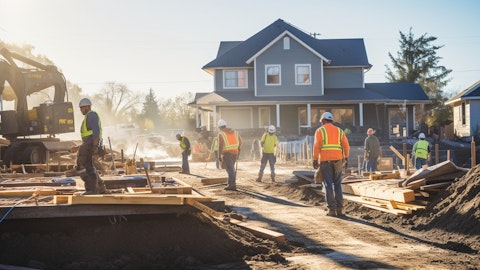Centerspace (NYSE:CSR) Q1 2025 Earnings Call Transcript May 2, 2025
Operator: Good afternoon and thank you for attending today’s Centerspace First Quarter 2025 Earnings Call. My name is Jaslyn, and I will be your moderator today. All lines will be muted during the presentation portion of the call with the opportunity for questions and answers at the end. [Operator Instructions]. I will now like to pass the conference over to your host, Josh Klaetsch with Centerspace. You may now proceed.
Josh Klaetsch: Good afternoon. Centerspace’s Form 10-Q for the quarter ended March 31, 2025, was filed with the SEC yesterday after the market closed. Additionally, our earnings release and supplemental disclosure package as well as an updated investor presentation have been posted to our website at centerspacehomes.com and filed on Form 8-K. It’s important to note that today’s remarks will include statements about our business outlook and other forward-looking statements that are based on management’s current views and assumptions. These statements are subject to risks and uncertainties discussed in our filings under the section titled Risk Factors and in other filings with the SEC. We cannot guarantee that any forward-looking statements will materialize and you’re cautioned not to place undue reliance on these forward-looking statements.
Please refer to our earnings release for reconciliations of any non-GAAP information, which may be discussed on today’s call. I’ll now turn it over to Centerspace’s President and CEO, Anne Olson, for the company’s prepared remarks.
Anne Olson: Hello everyone, and thank you for joining us. With me today are Bhairav Patel, our Chief Financial Officer; and Grant Campbell, SVP of Investments and Capital Markets. It is Friday and I know you are all anxious to ask us questions about what our plans are for the weekend. But first, we’d like to provide some brief highlights for the quarter. Our first quarter demonstrated our team’s ability to drive exceptional results with strong occupancy and expense control, bolstering our performance and setting us up well for the remainder of 2025. Multifamily fundamentals are strong with sustained demand driving net absorption across the industry. For us, strong demand translated into our results in several ways, most notably the 120 basis point year-over-year improvement in our weighted average occupancy for our same-store portfolio.
As we sit today, our average physical occupancy is 96% with April renewal retention coming in around 57%. Our blended leasing spreads shown on Page 8 of the investor presentation filed in connection with our earnings release and supplemental were up 70 basis points in the first quarter and the positive trend continued into April. Renewal increases have remained steady at a high 2% to mid-3% level, while new lease spreads are improving after being down 3.5% in Q4 2024, they increased sequentially to negative 1.1% in Q1 and in April, they moved to a positive 2.4%. Resident health remains strong with growth in income levels, keeping the rent to income ratio at 21.6%. Bad debt remains in line with expectations at roughly 40 basis points, while low unemployment rates and healthy regional economies point to the continuation of this trend.
Much of our footprint with its differentiated focus on Midwest and Mountain West regions of the country continues to benefit from a lack of new supply. Notably, North Dakota is again leading our portfolio with blended leasing spreads of 5.3% year-to-date, and Omaha has delivered similarly positive results. In our largest market of Minneapolis, leasing spreads are coming in ahead of our portfolio average and while we are still seeing the impact of supply pressure in Denver, we’re optimistic that the demand trend is strong enough to improve new lease rates as the year progresses. We feel great about the first quarter, even if it was uneventful. When considering the macroeconomic environment and its impact on our results and strategic direction, we are reaffirming our guidance for the full year.

We’re going to maintain discipline on all areas within our control and be ready to take advantage of opportunities to advance our platform. Grant will now share an overview of the state of the market and how it plays into our continued growth.
Grant Campbell: Thanks, Anne, and good afternoon, everyone. Within the investment landscape, we are seeing apartment demand remain resilient while new supply additions continue on a downward trend. As we look forward to the next 12 months, we expect only a 2.2% expansion of apartment stock in our markets. This is down from a 3.8% increase over the prior year and compares favorably to historical absorption levels. We anticipate this dynamic will continue to shift in our favor. Recent macroeconomic events have brought real time volatility to capital markets, though the amount of capital desiring to be in the multifamily space remains high, driven by forecasts for near-term strengthening of underlying rent growth and the long-term durability of the asset class.
This continues to bolster pricing on most transactions even in an environment where broader uncertainties persist. In Colorado and Minneapolis, where 59% of our NOI is generated, institutional quality assets are pricing at mid to high 4% and low 5% cap rates respectively. This represents favorable private market pricing compared to that implied by our stock price. On the capital allocation front, we will remain focused this year on enhancing our differentiated Mountain West and Midwest geography. We have fortified our balance sheet, enhanced our capital positioning, and we’ll continue evaluating a variety of new investment opportunities to advance our strategic plan. Current public market pricing and private market pricing are experiencing a disconnect and this will have to be considered in any transaction we explore.
On top of this, we are mindful that market exposures, leverage, share liquidity and scale are important considerations for investors. These variables sometimes compete with each other, and we will continue holistically evaluating and managing all of these considerations as we further implement capital allocation strategies to increase the quality of our cash flow. We are up to the task based on our track record of execution in pursuit of better every days. And with that, I’ll turn it over to Bhairav to discuss our overall financial results for Q1 and outlook for the remainder of 2025.
Bhairav Patel: Thanks, Grant, and hello, everyone. Last night, we reported core FFO of $1.21 per diluted share for the first quarter, driven by a 2.1% year-over-year increase in same-store NOI. NOI and earnings growth were right in line with our expectations and represent a solid start to the year. Revenues from same-store communities increased by 3.5% compared to the same quarter of 2024 and benefited from 120 basis point year-over-year increase in occupancy to 95.8%. That along with exposure at all-time lows optimally positions us heading into leasing season. The growth in revenue was offset by the expected increase in same-store expenses, which were up 5.8% year-over-year. The primary driver of the increase was property taxes as we received $680,000 in property tax appeal refunds in the first quarter of last year, creating a challenging year-over-year comp for the current quarter.
A slight increase relative to expectations and initial assessments received in a couple of jurisdictions also contributed to the increase. However, total expenses were in line with expectations due to offsetting savings across the Board on the controllable side. Turning to guidance, we reiterated our 2025 expectations in last night’s press release. Our Q1 operating performance was right on top of our projections for the quarter and the leasing trends evolving as expected, we remain on course to achieve the midpoint of $4.98 per share for core FFO and year-over-year same-store NOI growth of 2.25%. Other components of our guidance are substantially unchanged. On the capital front, our debt maturity profile remains well laddered with minimal maturities this year, a weighted average debt cost of 3.6% and a weighted average time to maturity of 5.4 years.
In the face of continued broader market volatility, our access to capital remains robust with over $223 million of total liquidity between our cash on hand and our line of credit. To conclude, Q1 was a great start to our year and positioned us to build upon these results throughout 2025. And with that, I will turn the line back to the operator for your questions.
Q&A Session
Follow Centerspace (NYSE:CSR)
Follow Centerspace (NYSE:CSR)
Receive real-time insider trading and news alerts
Operator: Thank you. We will now begin the Q&A session. [Operator Instructions]. Our first question comes from Brad Heffern with RBC Capital Markets. You may now proceed.
Brad Heffern: Hey everybody thanks for taking the question. You said in the prepared comments that operations are trending as expected. But I think the Midwest apartment market as a whole seems to be having a really strong start. Your occupancy is at record levels. I’m just wondering are you being conservative and modest early in the year or is there something that I’m missing because it just seems like things or actually ahead of plan?
Anne Olson: Yes. Thanks for the question, Brad, and happy Friday. You know this — we did expect that the Midwest was going to be strong this year. And in fact, we’re seeing that, as I mentioned, in areas like North Dakota and Omaha, even Minneapolis, which has had positive new lease spread since February in our portfolio. So I think we expected really strong growth, particularly given the strong performance last year. And therefore, we are right on plan. We are seeing really strong numbers that’s leading to a pretty big loss to lease in some of those markets. So not only thinking about this year, but into next year, we think there’s quite a bit of runway in those Midwest markets.
Brad Heffern: Okay, got it. And then, I think with last earnings, you said the guidance included flat occupancy for 2025. I think you said it’s up 120 basis points in the first quarter. So are you planning for that to give away a lot of that occupancy in the peak season in favor of rate? And then, Anne, you mentioned you would tell us what you’re going to do for the weekend. So I want to hear that too.
Anne Olson: Of course. Happy to answer both of those. So we are — our projections include occupancy around 95%. As you noted today we sit at 96%. That positions us really well as we head into those peak leasing. But we do expect it to come off, so that the overall average for the year will be 95%. If demand continues, we will continue to push rate and keep occupancy strong. For the weekend, I have some good family plans, Brad. I have some time with my mom and my sister’s plan for tomorrow, so hopefully some relaxing.
Brad Heffern: Great. Enjoy that. Thanks.
Operator: Thank you. Our next question comes from Ami Probandt with UBS. You may now proceed.
Ami Probandt: Hi, thanks. There was some lumpiness in the OpEx this quarter, particularly with elevated increases in real estate taxes and utilities. Understand that real estate taxes, some of that was due to a tough comp last year. But how should we be thinking about growth for the remainder of the year in these two lines and should we expect any additional lumpiness.
Anne Olson: Thanks, Ami. I’ll ask Bhairav to take that one.
Bhairav Patel: Yes, I’ll take that one. Yes. So there is some lumpiness. The lumpiness is expected to be in the first and the fourth quarters. That’s when we received most of our appeals last year. There is another component of the increase and that is basically some increased assessments that we received recently in a couple of jurisdictions. For example, in Denver, there are a couple of assessments that came in slightly higher. So we have increased our expectations for the year for tax increases to reflect that. The Denver increase at two parts, one was a true up of 2024, and another one was related to 2025 because we based 2025 expectations on 2024 results. But that should now be smooth going forward. There’s some lumpiness, as I said, that you’ll see in Q4 because we had some appeals that came in Q4 of last year as well.
But overall, we have increased the midpoint of our non-controllable spend by 2.25%, that’s a $650,000 increase and that’s really a result of the new assessments we’ve received most of it in Denver, but also a few in Minneapolis and Nebraska.
Ami Probandt: Got it, thanks. And retention came down in the quarter. So can you talk through some of the moving pieces that might be leading to you seeing a little bit higher turnover?
Bhairav Patel: Yes, I can start and Anne can chime in. I mean, there’s nothing really specific from a trend perspective that concerns us based on Q1 retention levels. It’s also a period where we have the least number of leases expiring. It’s about 14% of our portfolio terms in Q1. There was some noise in Nebraska as we were close to the last, where we’re basically rolling out the last value add project over there at a couple of properties that’s forced some move-outs. So normalizing for that in the low-50s and most importantly, April jumped to about 58%, 59% and the expirations in April were about 1,100 compared to 1,850 for Q1 in total. So overall, we do believe that retention will take up. We’ve already seen that happening in April. We do expect second quarter to have strong retention, so not really concerned about the recent trend.
Ami Probandt: Great. Thank you. Have a good weekend.
Operator: Thank you. Our next question comes from Jamie Feldman with Wells Fargo. You may now proceed.
Jamie Feldman: Great. Thank you. I was hoping you could talk more about Denver with the lowest new and renewal rate growth in your portfolio year-to-date. How do you see that market playing out over the rest of the year? When do you think we might see an inflection in rents there, particularly new rate growth? And do you think Denver stays weak into 2026?
Anne Olson: Yes, great questions, Jamie. I think lots of eyes on Denver and some good data points from our other public peers as well. So we’ve seen — as we look at April, we have about a 200 basis point improvement in new lease spreads between March and April alone, so some really good traction there. It’s about 270 basis points better than Q1 as a whole as we look just at the April results. So when we think about peak supply, really being kind of end of second into third quarter later in the year, I think 12 months out is where we believe we’ll really start to see the inflection point in the rates. So hopefully into Q3, we start seeing that those newly, those projects that were delivered in the fall of last year are starting to get stabilized.
The demand is very strong in Denver. The absorption has been pretty good and the demand at our properties has been strong, helping us to keep occupancy higher. So part of that is that the new projects do have higher rates overall. And so we feel really well-positioned to see an inflection yet this year and believe that our lease rates will turn positive towards the end of the year. But we’ve seen strong demand for our product in Denver. We don’t think that will taper off and we think that it will bring us into the end of the year positive and positive into 2026.
Jamie Feldman: Okay. Thank you for that. And then, just thinking about North Dakota, which continues to be one of your strongest markets with the highest new and renewal rate year-to-date. Does this change your view at all on capital recycling there in the more institutional markets when you consider weaker fundamentals in markets like Denver and probably much more competitive pricing on transactions?
Anne Olson: Yes. That’s a great question. It doesn’t change our thinking on that overall. We do like the stability that the Midwest provides because when there’s supply elsewhere, there’s usually not as much in the Midwest and the demand has stayed strong. There are still — those markets still remain small and so they can have sometimes a little bit more volatility, a little bit of supply in a town like Bizzmart can impact our results. The liquidity is still more limited in those markets. And I mean, there are reasons why North Dakota didn’t see as much supply last year. And those are really related to the underlying fundamentals of job and population growth. So being there has been great for us and it’s really provided a good balance to our markets like Denver, where the supply really did impact our new lease rates.
But it’s still — we still are thinking about capital recycling into markets that have stronger liquidity, more visibility for our investors and longer-term growth prospects related to underlying fundamentals of population and job growth.
Jamie Feldman: Okay. Thank you very much.
Operator: Thank you. Our next question comes from Rob Stevenson with Janney. You may now proceed.
Rob Stevenson: Good afternoon, guys. Anne or Grant, Page 20 of the slide deck has supply in second quarter spiking back up in your markets. Can you talk about what markets or submarkets where you still have significant supply to deal with over the remainder of the year and any markets where you’re not yet on the backside of the supply wave?
Grant Campbell: Yes. Good afternoon, Rob, good question. I think most notably the recent supply in Denver, as Anne alluded to in her earlier comments; we’re still working out the backside of that as we work through 2025 roughly 18,000 units were delivered in Denver over the past 12 months. A little over 50% of those were in urban and urban adjacent neighborhoods and about 47% of those deliveries were in suburban locations. So that is one market where although the Go Forward pipeline has significantly shrunk to below historical averages, we still are working through that tail. Rochester, Minnesota would be another market within our portfolio where if you look at our markets outside of Minneapolis and Denver, next 12 month forecast of deliveries are very minimal at call it 0% to 2.5% of existing stock.
The exception would be Rochester at about 4.5% that equates to about 500 new units delivering to that market. And anecdotally, I would comment on the other side of that equation. If you look at job growth within our portfolio, Rochester ranks as a top five metro in all of the United States in terms of job growth as of March. So I think you’re seeing the dynamics there of healthcare and education bringing a lot of employment to that region some supply is coming.
Rob Stevenson: Okay. And then in the deck where you were showing the second quarter-to-date, same-store leasing update, the 2.4% on new lease growth, what percentage you guys done with second quarter sitting here on May 2, is that 50% or 66% or more given that leases are signed well in advance of move in?
Anne Olson: Yes. We’re probably, I’d say 30% we’ve sent out through July 2026, but not all of those have come back in yet. So we probably have a good half of the expirations out quoted, but we won’t have those all back in. So I’d say between 25% and 30%.
Rob Stevenson: Of second quarter for April, May, June?
Anne Olson: Yes, yes, that’s right.
Rob Stevenson: Okay. So there’s 80% of the leases left to deal with at this point.
Anne Olson: Oh, yes. Where they still have time to provide us their indication, I mean, April is in the books, but people do take time. It might be a little bit higher than 30, but.
Rob Stevenson: Okay. And then last one for me, what drove the 220 basis point sequential decline in Omaha occupancy?
Anne Olson: Yes. As Bhairav mentioned, we did have some forced move-outs there related to the last wave of value-add. So when we complete value-add on a turn, you get to the end of the project and you have units that may not have turned. We do non-renew those residents so that we can complete the valuation. So that that created a little bit of noise in Omaha. Bhairav mentioned that earlier.
Rob Stevenson: Okay. All right. Thanks guys. Have a good weekend.
Operator: Thank you. Our next question comes from Alexander Goldfarb with Piper Sandler. You may now proceed.
Alexander Goldfarb: Hey, good afternoon out there. One have to say always love the strong North Dakota. That’s been — those markets have been good over the years. But my first question sort of goes against that, given we’re all learning about trade tariffs and roughly 17% of agriculture exports go to China. Just sort of curious how outside of Denver and Minneapolis, I’m talking how agriculture affects sort of the local economies and the markets that you’re in. Is it a big impact where if there’s some pullback in exports that would ripple through those other upper Midwestern markets or it’s pretty far away from the employment centers that drive your properties?
Anne Olson: Thanks, Alex. I think it’s the latter. So while there is an awful lot of agriculture as a base in states like North Dakota and even Nebraska, those aren’t the driving drivers of the economy. In the areas we’re in, which is Bismarck and Grand Forks; those are really driven by healthcare and education. Now, obviously agriculture has a big impact because they’re also regional centers. So to the extent there’s an impact in the outer areas or the more rural areas of those states, that is where those people would normally come for shopping to obtain healthcare. So there’s probably a little bit more of a secondary effect on the economy up there. And over time, North Dakota has shifted a little bit less agriculture and more onto the oil and gas. So the rural parts of the state are still very focused on oil and gas.
Alexander Goldfarb: Okay. And then…
Anne Olson: If you would like to continue to buy North Dakota pasta and sugar made from the sugar beets that helps.
Alexander Goldfarb: We’ll add that to my weekend list of activities. Going back to retention looking historically, I appreciate that you said it jumped up to 58% in April, but over the past year it’s been sort of in the 54%. So it’s been — it seems to be trending below what your other peer REITs are. So just sort of curious, are you seeing like either uncompetitive housing, so people can’t find a house or economic nervousness as to it doesn’t seem to be something that’s in your portfolio. I’m just trying to understand the slight difference, more than just a few properties in Nebraska, why your retention rates are sort of a different level than what we’re seeing in the Coastal and Sunbelt REITs.
Anne Olson: Yes. I think one driver in addition to Omaha, which we already covered, one driver would be our Denver retention was lower as we talked about, that has higher supply. So there are more choices in the market. So overall, the Q1 retention in Denver was in the mid-40s. That then is offset by really strong retention in some of our other markets. Our forecast and guidance includes an estimation of full year retention at like 51.5. So we’re still particularly with April running right in line with where we think, there may be some upside there we believe, but we really do, Denver being a large portfolio, it really does. It really will help us when there’s some more absorption in that market of the new product and we can get those retention rates back up.
Alexander Goldfarb: So the housing market, the dynamics that you’re experiencing and the unaffordability same in your markets that we’re seeing in the other markets. Is that right?
Anne Olson: Yes, I think that’s right. And if you look at the investor deck, we do some work and provide some data on housing affordability across our markets. It’s very, very similar to what you would see in some of the other market, Sunbelt markets and Coastal markets. And our people, number of residents who are moving out, who are saying they’re moving out to buy a home was just 6%.
Alexander Goldfarb: Wow. Okay. Thank you.
Operator: Thank you. Our next question comes from Mason Guell with Baird. You may now proceed.
Mason Guell: Hey, good afternoon, everyone. Going back to the solid positive inflection you’re seeing for new rates in the second quarter, can you kind of talk about how you expect new lease rates to play out for the year and has there been any change to expected blends for the year?
Anne Olson: Yes, it’s playing out just about how we thought it would — sorry, Bhairav. I’ll start and then you can jump in here. It’s playing out just about how we thought it would with respect to where we expected new lease rates to be, where we expect the blend to be. And we think that, that will continue to improve and then taper off into the fall. Typical seasonality would have us back negative on new lease rates slightly towards the end of the year. We — that’s still intact. So I think we — our original thesis of how we thought the year would progress is playing out and we don’t have any reason to make any big changes in that, which is part of the reasons why we’re affirming the guidance. So Bhairav, anything to add there?
Bhairav Patel: I think you covered it. It’s in line with expectations with us expecting the peak to happen in the May, June time frame and then kind of flattening out from there before it kind of tapers off towards the end of the year. So everything that Anne said.
Mason Guell: Got it. And what are you seeing in terms of attractive uses of capital or investment opportunities? And when would you expect to get back into acquisitions?
Anne Olson: We’ll let Grant take that one.
Grant Campbell: Yes. Good afternoon, Mason. We certainly do want to take advantage of investing opportunities when it makes sense with opportunities where we can advance our strategic plan. We do like the long-term fundamentals of the Mountain West. And we’re going to continue to focus on ways where we can enhance the differentiated offering that we can provide in that region. For us, we really like the Colorado portfolio that we’ve assembled over recent years. I think our goal in any new market would be to execute in a manner consistent with our Denver and Fort Collins growth. In terms of what form does that take? Acquisitions that could come with attractive embedded financing. It could be potential mezz executions, harder to make development math pencil today, but we continue to have those conversations.
We’re also talking to folks about potential mezz executions on recaps of existing assets. And then we always have lines in the water on the OP unit transaction front. So we’re turning over a lot of rocks. And when we find something that makes sense, we want to move on it.
Mason Guell: Thanks for the color. Have a great weekend, everyone.
Operator: Thank you. There are currently no questions registered. [Operator Instructions]. There are no questions waiting at this time. So I’ll pass the conference back over to the management team for any further remarks.
Anne Olson: Well, thanks, everyone for joining us. We hope you all have a great weekend and we look forward to seeing many of you in the coming weeks.
Operator: That concludes today’s conference call. Thank you for your participation. You may now disconnect your line.
Follow Centerspace (NYSE:CSR)
Follow Centerspace (NYSE:CSR)
Receive real-time insider trading and news alerts





